What is a dribble handoff in basketball
The dribble handoff, also known as a DHO, is a tactic consisting of offensive action that occurs when one player in possession of the basketball initially dribbles it toward a second player and then that same second player receives the ball, particularly via a handoff, to essentially dribble it as well for scoring or playmaking opportunities.
What is the difference between a conventional pass and a dribble handoff
The fundamental conventional passes in basketball include the chest pass, the bounce pass, and the overhead pass.
The main difference between these types of passes and the dribble handoff is that the conventional passes usually involve basketball spacing between the passer and the recipient while the dribble handoff features little to no spacing at all between the passer and the recipient.
For example, in a standard passing sequence, when player A executes a chest pass to player B, both players will usually be spaced apart about 12 to 15 feet or so.
However, in a dribble handoff sequence, when player A dribbles toward player B, this type of action closes the gap between the two players and afterwards, player A can pass, or more specifically, handoff the ball to player B.
It should also be known that generally speaking, spacing is a major factor, especially in reference to basketball offense.
Conversely, dribble handoff execution is probably one of the few instances in which it is beneficial for the offensive team, or more specifically between two offensive players (the passer and the recipient) to not focus on spacing, at least in the traditional sense basketball-wise.
Why is the dribble handoff potentially effective
The dribble handoff is potentially effective because it can be used to release pressure of the defender that is guarding the player which would receive the handoff.
Additionally, the dribble handoff could create opportunities for the player receiving the ball to take an open jump shot or potentially attack the basket with dribble drive action.
What are defensive tactics that could be implemented against the dribble handoff
The dribble handoff is somewhat similar to an on-ball screen in terms of the two-man action between the player executing the handoff and the player receiving the ball.
Generally speaking, the defensive team could limit or prevent the effectiveness of the dribble handoff with the same types of tactics that would typically be utilized against on-ball screens such as going under the handoff, executing a defensive hedge, or employing a defensive switch.
In addition to that, an off-ball defender could also limit or prevent the dribble handoff action, particularly by covering their assignment in such a way that that same assignment could not receive the handoff.
Essentially, the off-ball defender would jam up the space in between the offensive player with the ball and the offensive player that could receive it, mainly by using their body to impede the receiver’s cutting pathway to the ball.
This would be somewhat similar to how an off-ball defender implements denial defense so that the player that they are guarding cannot easily receive the ball via a conventional pass.
The examples below feature two offensive players, indicated as player A and player B as well as two defensive players, denoted as defender A and defender B.
Also, defender A and defender B guard against player A and player B, respectively, specifically with man to man defense.
Go under the handoff
If player A with possession of the ball dribbles it toward player B, then defender B could go under player A during the handoff exchange, which effectively limits or completely stops dribble penetration following the handoff action.
Implement a defensive hedge
If player A with possession of the ball dribbles toward player B, then defender B could implement a defensive hedge slightly above player A during the moment of the handoff to limit or prevent dribble penetration.
Afterwards, following the hedge action, defender B should have enough time to recover to player B who now has the ball and at the same time, defender A could recover as well.
Execute defensive switching
If player A with possession of the ball dribbles toward player B, then defender A could switch to guard player B while defender B switches to guard player A after the handoff exchange occurs.
What are basic offensive counters against dribble handoff defense
A few basic counters that the offensive team could execute against the dribble handoff defense include the backdoor cut, the fake handoff, and the re-screen action.
The offensive team could implement these counters by reading the defense and executing the most suitable one accordingly.
Related: Dribble Handoff Counters – FastModel Sports
Backdoor Cut
The backdoor cut could be utilized as a counter if the defense attempts to jam up the handoff action. It is also more effective when there is an open post for easy scoring opportunities at the basket.
For example, let’s say that player A dribbles towards player B but defender B jams up the possible handoff exchange. When that occurs, player B could backdoor cut to the basket, receive the ball from player A, and score at the rim with a layup or dunk.
Fake Handoff
The fake handoff could be potentially effective against the defensive switch. With the fake handoff, player A would dribble towards player B and briefly slow down their speed as if to initiate the exchange.
Following that though, player A would then quickly increase their speed, and dribble drive to the basket for a layup.
Re-Screen
The re-screen could be used as a counter against the go under technique and it could be possibly effective when the player executing the handoff is a post player and the receiver of the handoff is a perimeter player.
To demonstrate a re-screen scenario, let’s say that player A with possession of the ball dribbles towards player B to execute the handoff as normal.
However, let’s also say that defender B successfully goes under player A to stay in front of player B.
When that occurs, player A could quickly pivot turn and establish an on-ball screen for player B. Afterwards, player B could use the on-ball screen to attack the basket, take an open jump shot, or pass the ball to another teammate.
Related: Re-Screen Examples – YouTube
What is an example of a dribble handoff continuity
Continuity Example – Part 1
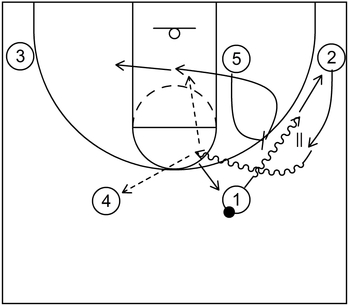
This is an example of a simple dribble handoff continuity from a wide 4 out 1 in alignment which also includes on-ball screens near the wings.
To start, 1 dribbles towards 2 to execute the handoff action. Next, 2 dribbles toward the middle of the lane via the on-ball screen set by 5.
After that, 5 rolls to the basket while 1 fills the vacated right corner previously occupied by 2. From this point, 2 could take the open mid-range jump shot or drive and score at the basket.
Additionally, as an alternative option, 5 could receive the ball from 2 and score near the basket as well.
Furthermore, 4 could receive the ball from 2 and if that occurs, then 2 fills the right slot area previously occupied by 1, 5 continues the cut to the left side low post block, and the continuity could begin on the other side of the court.
Continuity Example – Part 2
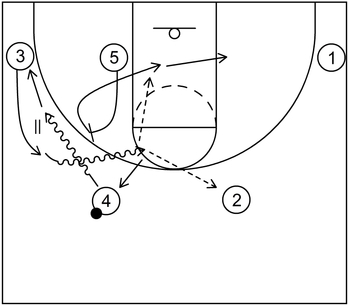
To start the continuity, 4 dribbles toward 3 to execute the handoff and following that, 3 dribbles to the middle of the lane via the on-ball screen set by 5. From there, 5 rolls to the basket while 4 fills the left side corner.
Next, 3 could take the mid-range jump shot or drive to score at the rim. Also, as a secondary option, 5 could receive the ball from 3 and score at the basket as well.
If those scoring options are not available, then 2 could receive the ball from 3. When that happens, 3 fills the left slot area while 5 cuts across to the right side low post block.
Afterwards, 2 could execute the continuity once again on the opposite side of the floor.
What is an example of a set play with dribble handoff actions
Set Play Example – Part 1

This is an example of a set play from the Horns offense that features dribble handoff action. Additionally, there is an on-ball screen between the two high post players, which is also known as elbow get action.
To start, 4 receives the ball from 1 and after that, 1 quickly cuts to the basket. If 1 is open on the cut, then 1 could receive the ball from 4 and score at the basket.
Otherwise, 1 cuts out to the right side corner and at the same time, 2 lifts up to the right side wing area.
Set Play Example – Part 2
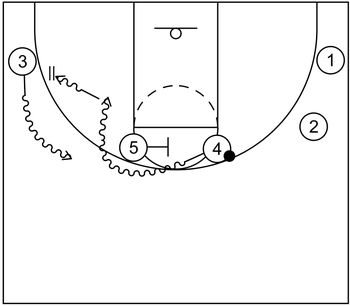
Next, 4 drives to the basket via the on-ball screen set by 5 and could score with a layup or dunk. If 4 is not able to get all the way to the rim, then 4 could dribble towards 3 and execute a handoff.
After 3 receives the ball near the left side corner, 3 could dribble back up towards the left side wing area. At the same time, 4 could fill the left side corner, previously occupied by 3.
Set Play Example – Part 3
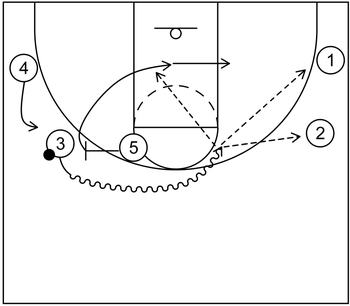
Next, 3 could dribble towards the middle of the court via the on-ball screen set by 5. Afterwards, 5 could roll to the basket while 4 lifts up to the left side wing.
Once that occurs, 3 could take the mid-range jump shot or 5 could receive the ball from 3 and score near the basket.
Also, 1 or 2 could receive the ball from 3 and take three-point jump shots if open. If no players are open for scoring opportunities, then 3 could dribble towards the right side slot area while 5 cuts across to the right side low post block.
Set Play Example – Part 4
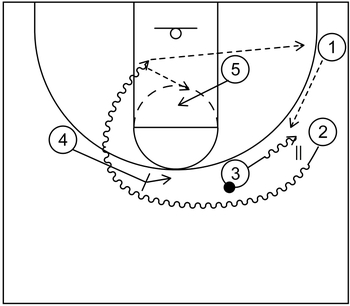
Following that, 3 could dribble towards 2 to execute a handoff. After receiving the ball, 2 could drive towards the basket via the on-ball screen set by 4.
Also, as 2 executes the dribble drive action, 5 could step into the lane, receive the short pass from 2, and then score at the rim.
Next, 1 could receive the drift pass from 2 and take the open jump shot. Additionally, if 1 receives the ball but is not open to take the shot, then 3 could receive the ball from 1 for another possible jump shot opportunity.
Affiliate Disclosure: I may earn a commission on qualifying purchases made through the links below.
What is an example of a basketball drill that features dribble handoff action
Part 1
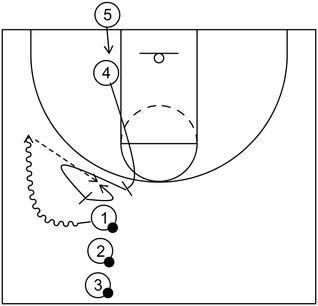
This is an example of a basketball drill that features an on-ball screen, dribble handoff action as well as pick and pop action, primarily for the team’s best three-point shooting post players.
This drill could also help develop players’ abilities to set a re-screen, particularly against ice defense action.
It is derived from Developing Interchangeable Perimeter & Post Players by Matt Painter.
Moreover, for this drill, 1, 2, and 3 are perimeter players while 4 and 5 are post players. However, it is possible to allow any specific player to set the on-ball screen and pop out for a jump shot, depending on team personnel.
The setup of the drill includes a line of perimeter players, each in possession of a basketball, near the left slot area. Additionally, one post player fills the left side low post block while the other post player stands behind the baseline, adjacent to the other post player.
Furthermore, there is a coach, team manager, or perhaps another secondary player, indicated by the letter C, near the right side low post block. The main objective of this particular person is to rebound the basketball on a made or missed shot and pass it back to a player without a ball near the slot.
To start, 4 sprints high to set an on-ball screen for 1 near the top. However, for demonstration purposes, it is assumed that a defender seeks to take away that dribble penetration towards the middle by icing the ball screen.
When that occurs, 4 quickly re-screens in the other direction, which also happens to be a step-up screen. From there, 1 quickly dribbles toward the left side wing via the step-up screen set by 4.
Following the screening action, 4 simply pops with a pivot turn and receives the ball from 1. Also, while all of that occurs, 5 could step up to fill the vacant left side low post for the time being.
Part 2

Next, 4 executes a dribble handoff with 1 near the left side wing and afterwards, 4 pops to the left side corner. As that pop action occurs, 1 dribbles the ball once or twice towards the top and following that, 4 receives the ball from 1.
From there, 4 takes the open three-point jump shot. It should also be noted that 4 could take a mid-range shot as well, particularly if the three-pointer is outside of the range of 4.
After 4 makes or misses the jump shot, the coach, manager, or secondary player grabs the basketball and then 1 receives the ball from that same coach, manager, or secondary player.
Following that, 1 moves to the back of the line near the left slot while 4 moves to the area behind the baseline adjacent to 5.
Once that occurs, the drill could start over again. That is to say, 5 could set an on-ball screen for 2 and afterwards, 2 could use that screen, pass to 5, and so forth.